Revealing the Driving Factors of Land Disputes in China: New Insights from Machine Learning and Interpretable Methods
Abstract
1. Introduction
2. Data, Models, and Methods
2.1. Data and Sources
2.1.1. Variable and Sources
2.1.2. Variable Preprocessing
2.2. Models and Methods
2.2.1. Gradient Boosting Decision Tree (GBDT)
2.2.2. Interpretability Methods for Machine Learning Models
3. Results
3.1. Spatiotemporal Evolution of LDI
3.2. Importance of Driving Factors
3.3. Nonlinear Effects
3.4. Interaction Effect
3.5. Robustness Test
3.5.1. Model Performance
3.5.2. Variable Importance Test
4. Discussion
5. Conclusions
Author Contributions
Funding
Data Availability Statement
Conflicts of Interest
References
- Rahman, A.; Hossain, R. The uncomfortable truth about land disputes in Bangladesh: Insights from a household survey. Land Use Policy 2020, 95, 104557. [Google Scholar] [CrossRef]
- Winters, M.S.; Conroy, K.J. Preferences for traditional and formal sector justice institutions to address land disputes in rural Mali. World Dev. 2021, 142, 105452. [Google Scholar] [CrossRef]
- Goodale, M.G.; Sky, P.K. A comparative study of land tenure, property boundaries, and dispute resolution: Case studies from Bolivia and Norway. J. Rural. Stud. 2001, 17, 183–200. [Google Scholar] [CrossRef]
- Foweraker, J. The Struggle for Land: A Political Economy of the Pioneer Frontier in Brazil from 1930 to the Present Day; Cambridge University Press: Cambridge, UK, 2002. [Google Scholar]
- Greiner, C.; Greven, D.; Klagge, B. Roads to change: Livelihoods, land disputes, and anticipation of future developments in rural Kenya. Eur. J. Dev. Res. 2021, 33, 1044–1068. [Google Scholar] [CrossRef]
- Nguyen, T.H.T.; Tran, V.T.; Bui, Q.T.; Man, Q.H.; de Vries Walter, T. Socio-economic effects of agricultural land conversion for urban development: Case study of Hanoi, Vietnam. Land Use Policy 2016, 54, 583–592. [Google Scholar] [CrossRef]
- Zhang, M.; Tan, S.; Chen, E.; Li, J. Spatio-temporal characteristics and influencing factors of land disputes in China: Do socio-economic factors matter? Ecol. Indic. 2024, 160, 111938. [Google Scholar] [CrossRef]
- Tan, S.; Tong, B.; Zhang, J. How did the land contract disputes evolve? Evidence from the Yangtze River Economic Belt, China. Land 2023, 12, 1334. [Google Scholar] [CrossRef]
- You, H.; Zhang, J.; Song, Y. Assessing conflict of farmland institutions using credibility theory: Implications for socially acceptable land use. Land Use Policy 2022, 112, 105817. [Google Scholar] [CrossRef]
- Xia, Y.; Zhang, R.; Qu, S. Countermeasures of rural land contract management dispute resolution based on large sample survey. Acad. J. Zhongzhou 2018, 3, 38–44. [Google Scholar]
- Li, L.; Gao, H.; Song, B.; Cui, C. How to use evidence rules reasonably to resolve land disputes: Analysis of typical land dispute cases from China. Land 2024, 13, 1187. [Google Scholar] [CrossRef]
- Caspari, V. The economy of ancient Greece and the beginning of economic thought. In A History of Economics; Springer Studies in the History of Economic Though; Springer: Berlin/Heidelberg, Germany, 2024. [Google Scholar]
- Bai, C. Social foundations and prospective administration of rural land disputes. China Land Sci. 2007, 6, 35–40. [Google Scholar]
- Deininger, K.; Castagnini, R. Incidence and impact of land conflict in Uganda. J. Econ. Behav. Organ. 2006, 60, 321–345. [Google Scholar] [CrossRef]
- Hashem, D.; Somayeh, A. Land tenure-related conflicts in peri-urban areas: A review. Land Use Policy 2019, 85, 218–229. [Google Scholar]
- Xu, K.; Su, J.; Bao, H.; Dang, Y.; Xu, W. Risk characteristics, transmission pathways and regulatory strategies in the secondary land market: Based on content analysis of 2045 land disputes court cases. China Land Sci. 2024, 38, 50–60. [Google Scholar]
- Tan, S.; Zou, S. Study on the evolution characteristics and influencing factors of land disputes in the Yangtze River Economic Belt. China Land Sci. 2022, 36, 22–31. [Google Scholar]
- Iswantoro, I. Strategy and management of dispute resolution, land conflicts at the land office of Sleman Regency. J. Hum. Rights Cult. Leg. Syst. 2021, 1, 1–18. [Google Scholar] [CrossRef]
- Morán Uriel, J.; Camerin, F.; Córdoba Hernández, R. Urban horizons in China: Challenges and opportunities for community intervention in a country marked by the Heihe-Tengchong Line. In Diversity as Catalyst: Economic Growth and Urban Resilience in Global Cityscapes; Siew, G., Allam, Z., Cheshmehzangi, A., Eds.; Urban Sustainability; Springer: Singapore, 2024. [Google Scholar]
- Simmons, C.S. The political economy of land conflict in the Eastern Brazilian Amazon. Ann. Assoc. Am. Geogr. 2004, 94, 183–206. [Google Scholar] [CrossRef]
- Mccarthy, J.F.; Dhiaulhaq, A.; Afiff, S.; Robinson, K. Land reform rationalities and their governance effects in Indonesia: Provoking land politics or addressing adverse formalization? Geoforum 2022, 132, 92–102. [Google Scholar] [CrossRef]
- Dietz, K.; Engels, B. Analyzing land conflicts in times of global crises. Geoforum 2020, 111, 208–217. [Google Scholar] [CrossRef]
- Ullah, I.; Hussain, S. Impact of early access to land record information through digitization: Evidence from Alternate Dispute Resolution Data in Punjab, Pakistan. Land Use Policy 2023, 134, 106917. [Google Scholar] [CrossRef]
- Ibrahim, A.S.; Abubakari, M.; Akanbang, B.A.; Kepe, T. Resolving land conflicts through Alternative Dispute Resolution: Exploring the motivations and challenges in Ghana. Land Use Policy 2022, 120, 106272. [Google Scholar] [CrossRef]
- Asaaga, F.A. Building on “Traditional” land dispute resolution mechanisms in rural Ghana: Adaptive or anachronistic? Land 2021, 10, 143. [Google Scholar] [CrossRef]
- Obala, L.M.; Mattingly, M. Ethnicity, corruption and violence in urban land conflict in Kenya. Urban Stud. 2014, 51, 2735–2751. [Google Scholar] [CrossRef]
- He, X. Analysis of potential risks of industrial and commercial capital flowing into rural areas. Discov. Chin. Rural. Areas 2014, 3, 125–131. [Google Scholar]
- Chu, Y. China’s new urbanization plan: Progress and structural constraints. Cities 2020, 103, 102736. [Google Scholar] [CrossRef]
- Hu, Y.; Zhou, K.; Lei, Y. Study on land disputes resolving and risk warning mechanism construction in the process of urbanization: From the perspective of Social Burning Theory. Res. Agric. Mod. 2015, 36, 68–972. [Google Scholar]
- Lin, Q.; Tan, S.; Zhang, L.; Wang, S. Conflicts of land expropriation in China during 2006–2016: An overview and its spatio-temporal characteristics. Land Use Policy 2018, 76, 246–251. [Google Scholar] [CrossRef]
- Chen, Y.; Ni, X. Study on distribution disputes of land expropriation compensation for contracted land within collective communities: Based on 1091 cases of disputes and court verdicts in Hunan province. China Land Sci. 2021, 35, 43–51. [Google Scholar]
- Whiting, S. Values in land: Fiscal pressures, land disputes and justice claims in rural and peri-urban China. Urban Stud. 2011, 48, 569–587. [Google Scholar] [CrossRef]
- Huang, Z. Disembeddedness and re-embeddedness: Agricultural operation and governance in village order. China Rural. Surv. 2018, 3, 51–64. [Google Scholar]
- Xu, Z. The social context of capital going to the countryside: A case study of agriculture enterprise in northern China. Sociol. Stud. 2016, 31, 63–87. [Google Scholar]
- Xu, X.; Zhang, L.; Liu, X. Disputes over farmland transfer: Breach of contract mechanism and its empirical study. J. China Agric. Univ. 2020, 25, 216–230. [Google Scholar]
- Qu, S.; Guo, J.; Xia, Y. Did rural land rights confirmation and land adjustment resolve land disputes?—Evidence from micro-level data. J. Northwest AF Univ. 2018, 18, 71–78. [Google Scholar]
- Zhou, M.; Lei, G.; Li, J. Capital inflow in village, property evolution and farmland transfer conflict. China Land Sci. 2015, 29, 55–62. [Google Scholar]
- Chen, R.; Chen, P. Farmer land rights security mechanism building in the agriculture modernization process survey on agriculture-related enterprise participate in farmland transfer in L city in the middle of Henan. J. Huazhong Agric. Univ. 2013, 5, 55–60. [Google Scholar]
- Nkobou, A.T.; Ainslie, A.; Lemke, S. Broken promises: A rights-based analysis of marginalized livelihoods and experiences of food insecurity in large-scale land investments in Tanzania. Food Secur. 2022, 14, 185–205. [Google Scholar] [CrossRef]
- Chen, Y.; Jin, X. How do farmers realize their rights on the collective land in rural China? An explanatory framework for deconstructing the subject of collective land ownership. Land 2023, 12, 1746. [Google Scholar] [CrossRef]
- Lombard, M.; Rakodi, C. Urban land conflict in the Global South: Towards an analytical framework. Urban Stud. 2016, 53, 2683–2699. [Google Scholar] [CrossRef]
- Gao, R.; Cai, H.; Xu, X. Analysis of Driving Factors of Cropland Productivity in Northeast China Using OPGD-SHAP Framework. Land 2025, 14, 1010. [Google Scholar] [CrossRef]
- Zhao, J.; Jia, B.; Wu, J.; Wu, X. Study of spatial and temporal characteristics and influencing factors of net carbon emissions in Hubei province based on interpretable machine learning. Land 2025, 14, 1255. [Google Scholar] [CrossRef]
- Ding, C. Policy and praxis of land acquisition in China. Land Use Policy 2007, 24, 1–13. [Google Scholar] [CrossRef]
- Cao, D.; Wang, Y.; Zang, L. Land reallocation and collective action in the commons: Application of social-ecological system framework with evidence from rural China. Land Use Policy 2024, 144, 107267. [Google Scholar] [CrossRef]
- Wang, Y. The impact of farmland transfer direction on land disputes: A rural panel data analysis based on 30 Chinese provinces. Ind. Innov. 2020, 16, 9–13. [Google Scholar]
- Ma, X.; Qiu, T.; Qian, Z. Farmland tenure security and farmers’ participation in the farmland transfer market: An empirical analysis based on survey data from four provinces. Chin. Rural. Econ. 2015, 2, 22–37. [Google Scholar]
- Krul, K.; Peter, H.; Yang, X. Land titling as a conflict remedy or driver? Analyzing institutional outcomes through latent and manifest conflicts in China’s forest sector. Land Use Policy 2021, 100, 104880. [Google Scholar] [CrossRef]
- Li, Y.; Lv, M. Study on the construction of farmers’ sustainable livelihood model in the process of capital to the countryside. J. Huazhong Agric. Univ. 2019, 2, 63–70. [Google Scholar]
- Wan, J.; Liu, Y.; Zhang, X. Conflict in informal rural construction land transfer practices in China: A case of Hubei. Land Use Policy 2021, 109, 105573. [Google Scholar] [CrossRef]
- Sanz, H.; Valim, C.; Vegas, E.; Oller, J.M.; Reverter, F. SVM-RFE: Selection and visualization of the most relevant features through non-linear kernels. BMC Bioinform. 2018, 19, 432. [Google Scholar] [CrossRef] [PubMed]
- Lundberg, S.M.; Lee, S. A unified approach to interpreting model predictions. In Proceedings of the 31st International Conference on Neural Information Processing Systems, Long Beach, CA, USA, 4–9 December 2017. [Google Scholar]
- Sagi, O.; Rokach, L. Ensemble learning: A survey. Wiley Interdiscip. Rev. Data Min. Knowl. Discov. 2018, 8, e1249. [Google Scholar] [CrossRef]
- Lalchand, V. Extracting more from boosted decision trees: A high energy physics case study. arXiv 2020, arXiv:2001.06033. [Google Scholar] [CrossRef]
- Tao, S.; Wu, X.; Fang, K.; Lin, D. Identifying drivers of county-level industrial carbon intensity by a generic machine learning framework. J. Clean. Prod. 2024, 454, 142276. [Google Scholar] [CrossRef]
- Yang, L.; Fang, C.; Chen, W.; Zeng, J. Urban-rural land structural conflicts in China: A land use transition perspective. Habitat Int. 2023, 138, 102877. [Google Scholar] [CrossRef]
- Ding, X.; Zhang, B.; Shen, C.; Wang, R.; Yin, S.; Li, F.; Xu, C. Are we underestimating the driving factors and potential risks of freshwater microplastics from in situ and in silico perspective? Water Res. 2025, 281, 123568. [Google Scholar] [CrossRef] [PubMed]
- Zhao, Y.; Ge, W.; Sun, Y.; Qiao, G.; Zhu, D.; Ai, H. Examining nonlinear effects of socioecological drivers on urban solar energy development in China using machine learning and high-dimensional data. J. Environ. Manag. 2024, 360, 121092. [Google Scholar] [CrossRef]
- Liao, X.; Ying, R.; Deng, H.; Xu, Z. The income effect and benefit distribution: Analysis on the effect of farmers’ cooperation. China Soft Sci. 2016, 5, 30–42. [Google Scholar]
- Hyacinth, O.E.; George, M.; Bedru, B.B. Land tenure security and preferences to dispute resolution pathways among landholders in Nigeria. Land Use Policy 2022, 119, 106179. [Google Scholar] [CrossRef]
- Guan, H. Legal risks and countermeasures in the reform of contracted farmland “Merging small fields with large fields”. Acad. J. Zhongzhou 2024, 3, 30–38. [Google Scholar]
- Hou, J. Capital to countryside: Perspective from farmers—Based on investigation from 3203 farming families in 214 villages nationwide. J. Huazhong Agric. Univ. 2015, 1, 81–87. [Google Scholar]
- Qi, X.; Wang, X. Factors influencing the citizenization of rural-urban migrants: A study based on machine learning. Chin. Rural. Econ. 2024, 5, 128–150. [Google Scholar]
- Wang, Y.; Zhang, Y.; Li, J. Digital finance and carbon emissions: An empirical test based on micro data and machine learning model. China Popul. Resour. Environ. 2022, 32, 1–11. [Google Scholar]
- Nandwani, B. Community forestry and its implications for land related disputes: Evidence from India. Eur. J. Political Econ. 2022, 73, 102155. [Google Scholar] [CrossRef]
- Rakgwale, M. The role of mediation in land disputes in Africa. In Dispute Resolution Within Africa; Baboolal Frank, R., Ed.; Springer: Cham, Switzerland, 2024. [Google Scholar]
- Czarnecki, A.; Milczarek, A.D.; Widła, D.Ł.; Jórasz, Z.A. Conflict dynamics over farmland use in the multifunctional countryside. Land Use Policy 2023, 128, 106587. [Google Scholar] [CrossRef]
- Putnam, R.D. Making Democracy Work: Civic Traditions in Modern Italy; Princeton University Press: Princeton, NJ, USA, 1993. [Google Scholar]
- Tan, S.; Zou, S.; Zhao, Y.; He, Q.; Zhang, M. Research on the Manifestation and Formation Mechanism of New Characteristics of Land Disputes: Evidence from the Yangtze River Economic Belt, China. Land 2024, 13, 1002. [Google Scholar] [CrossRef]
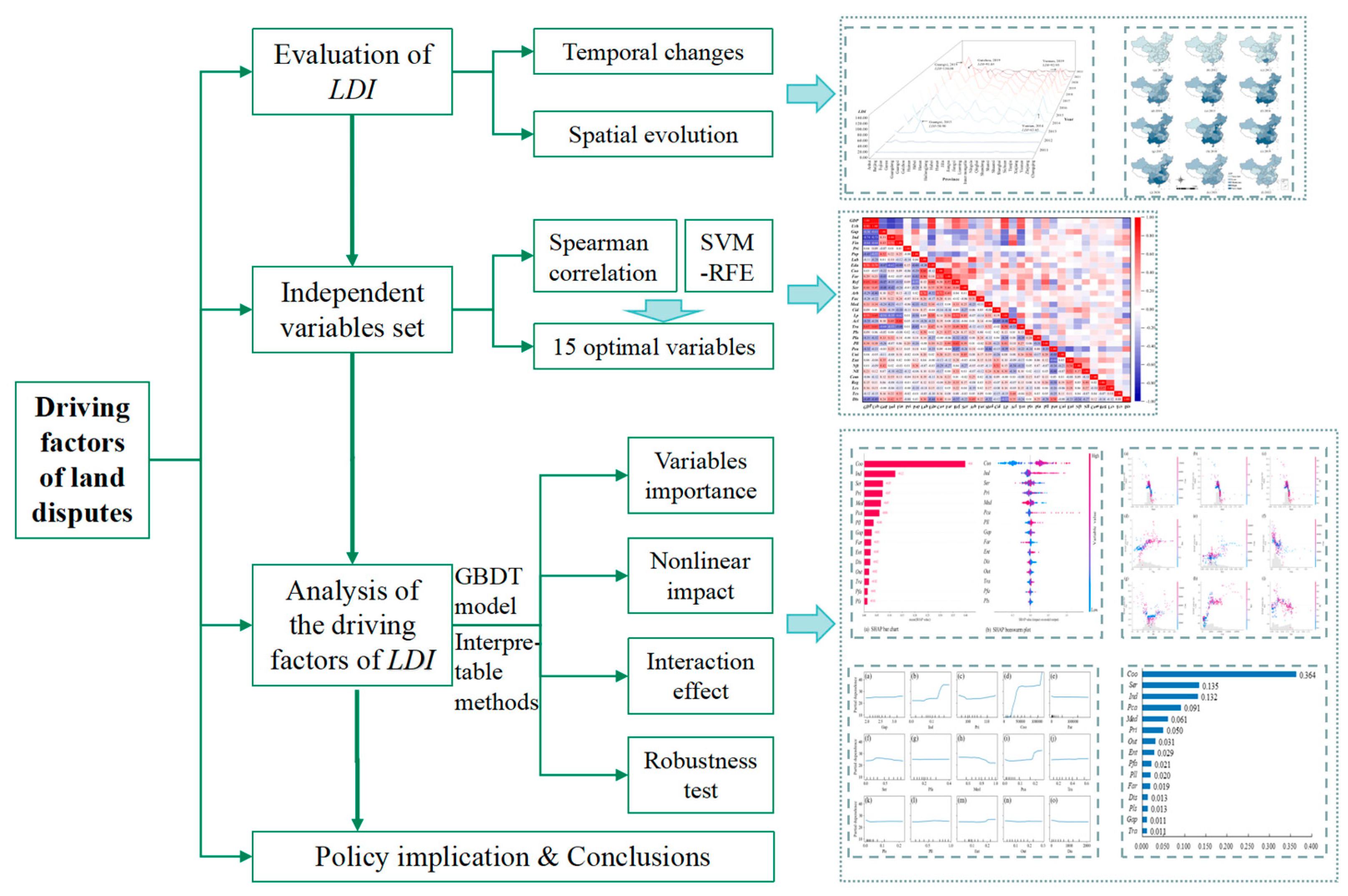
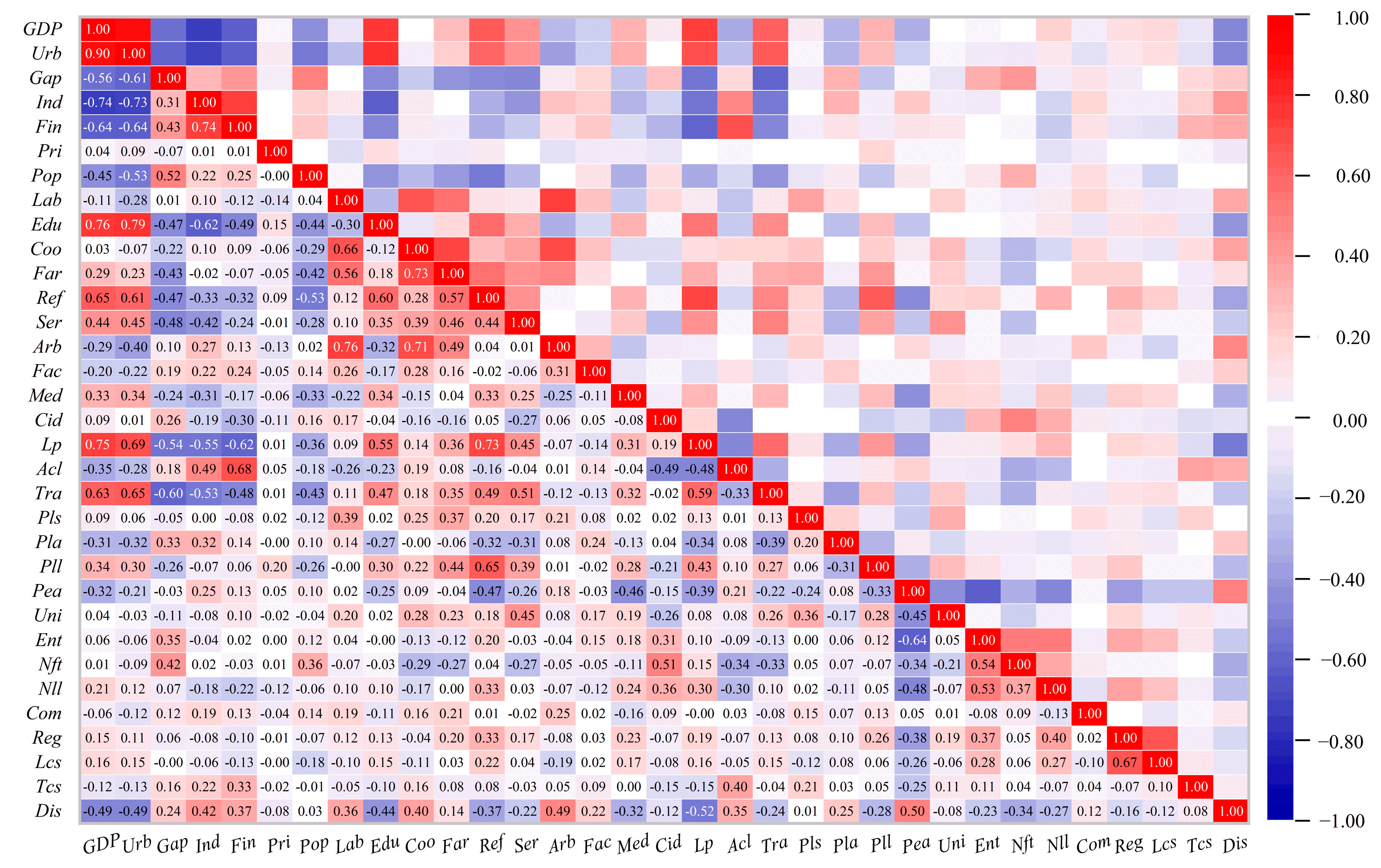
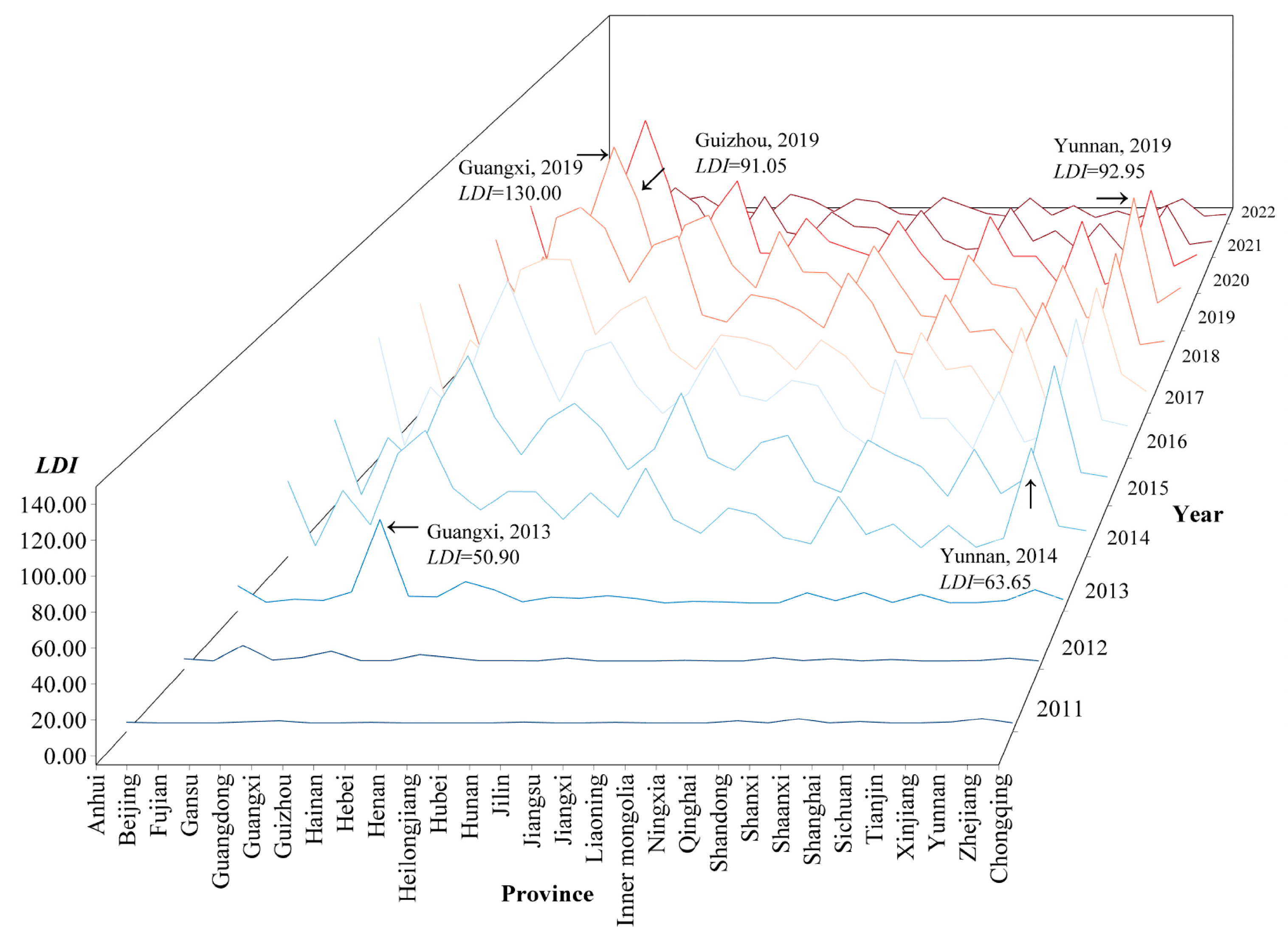
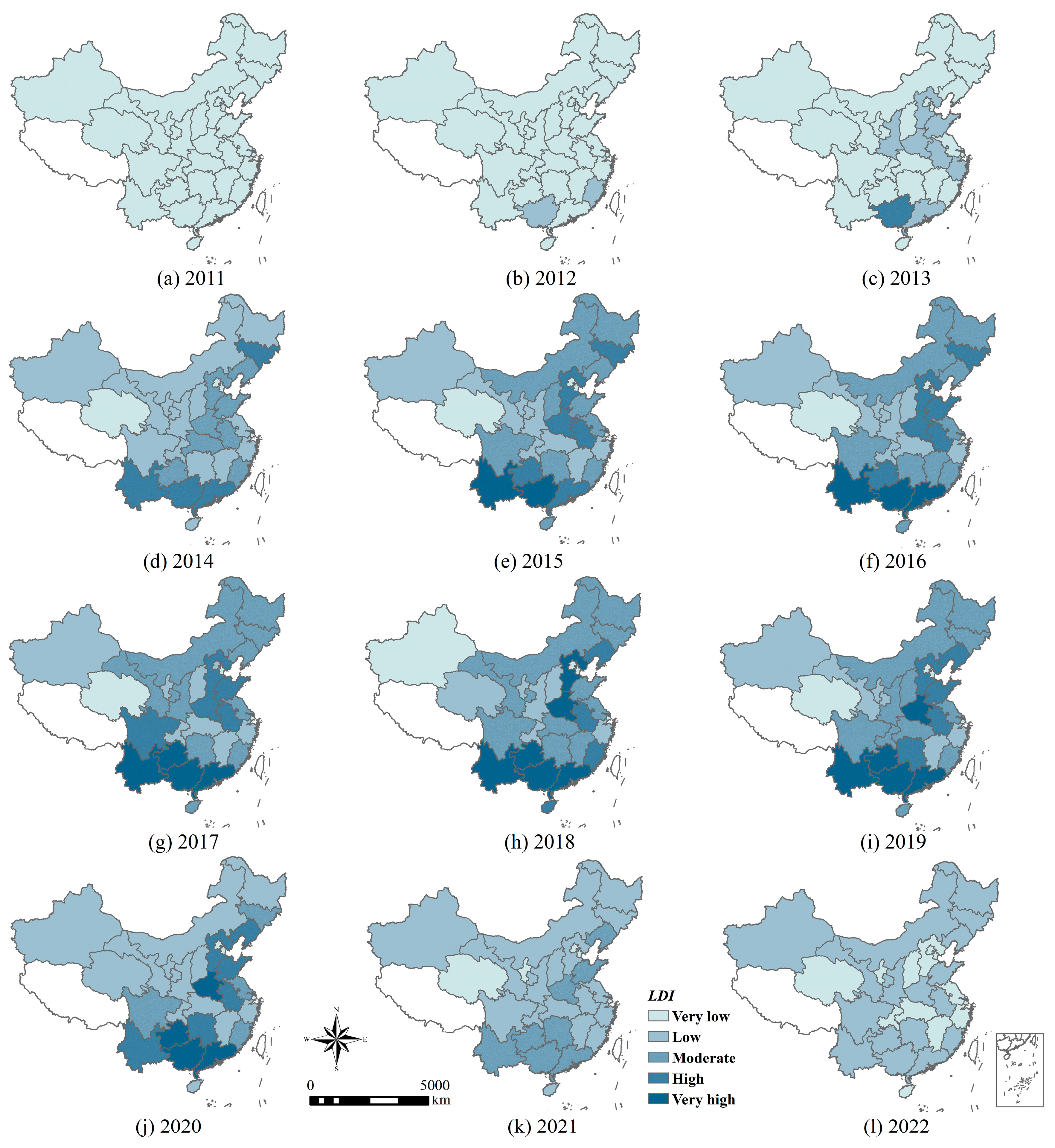
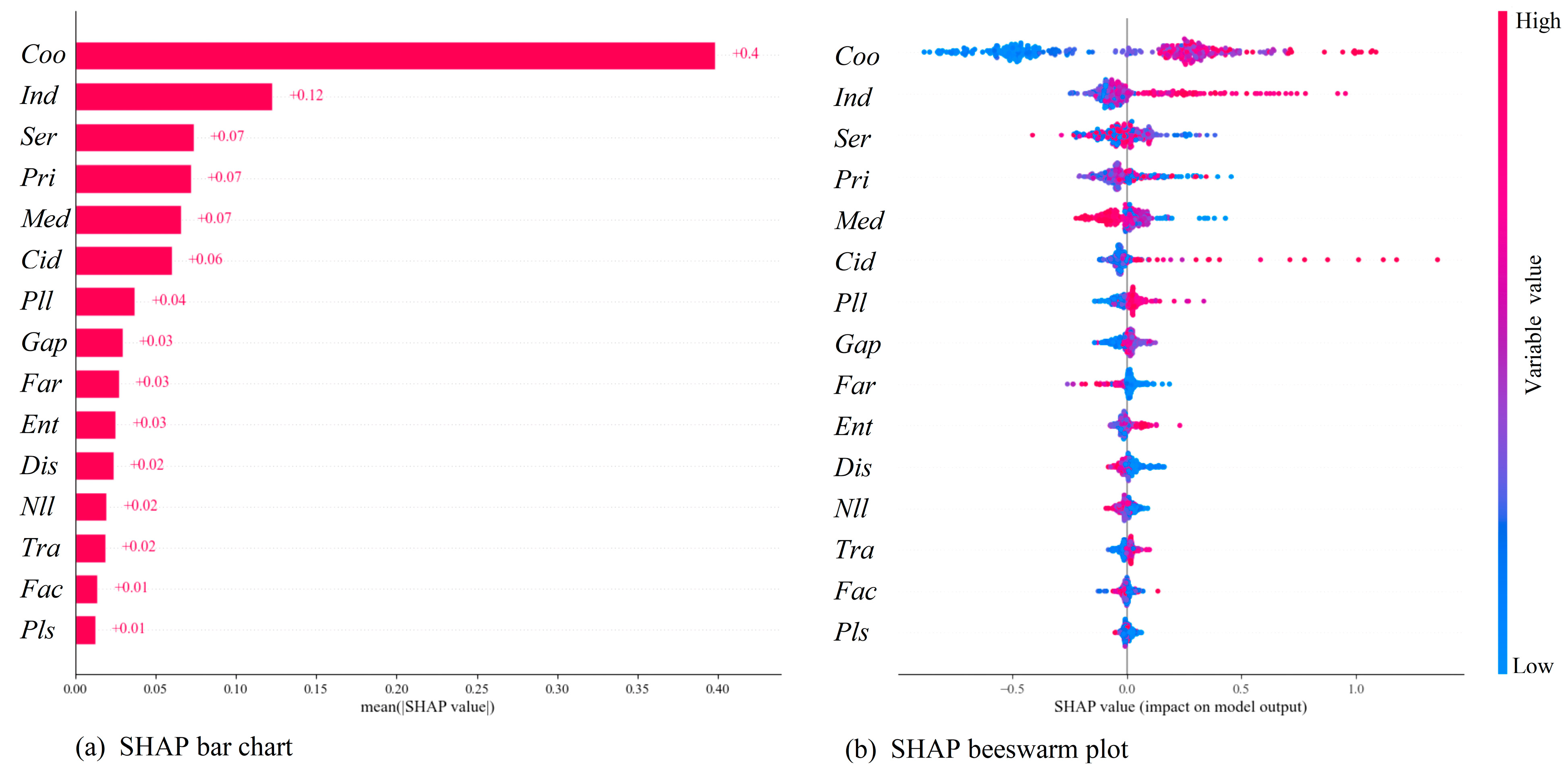
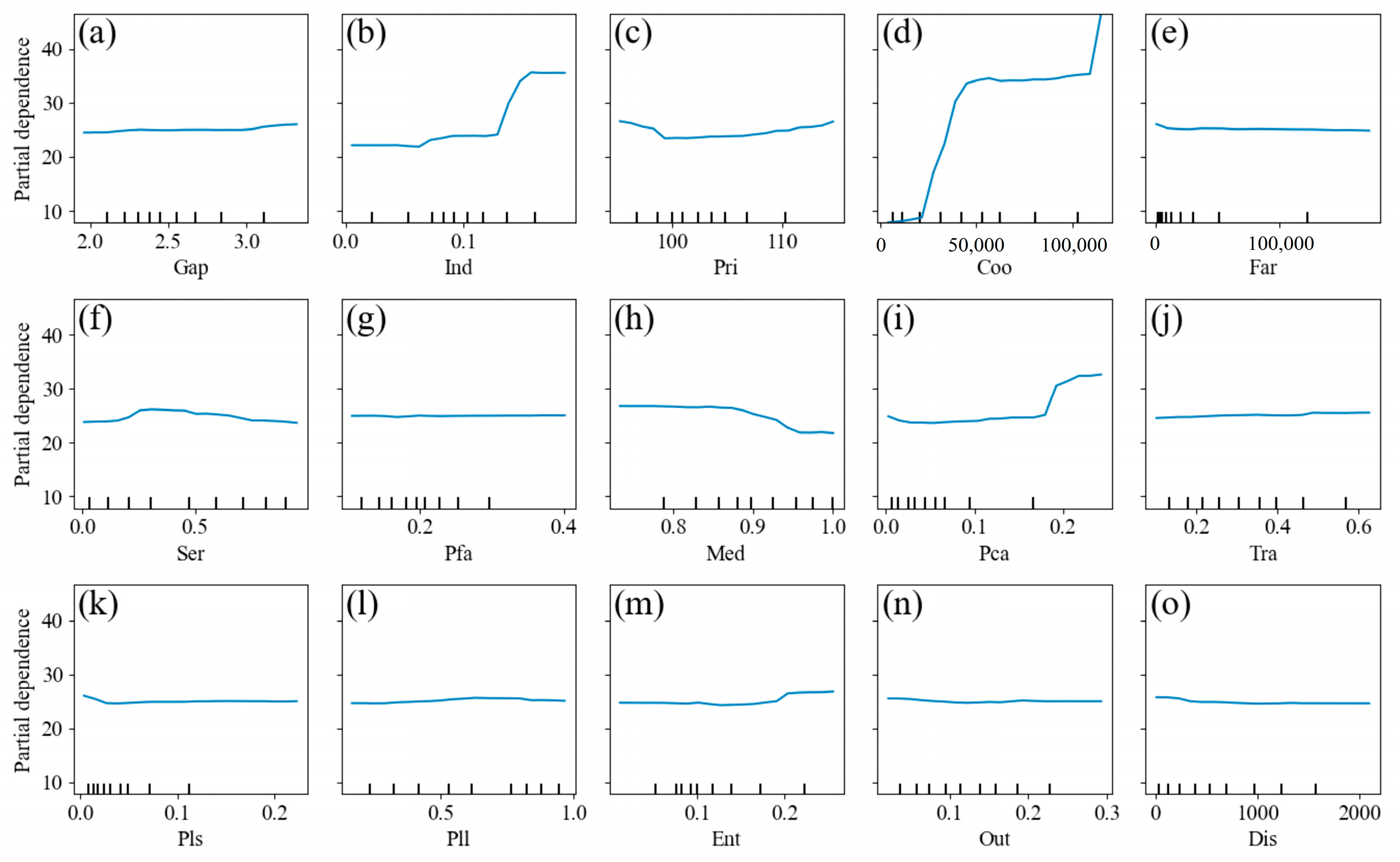
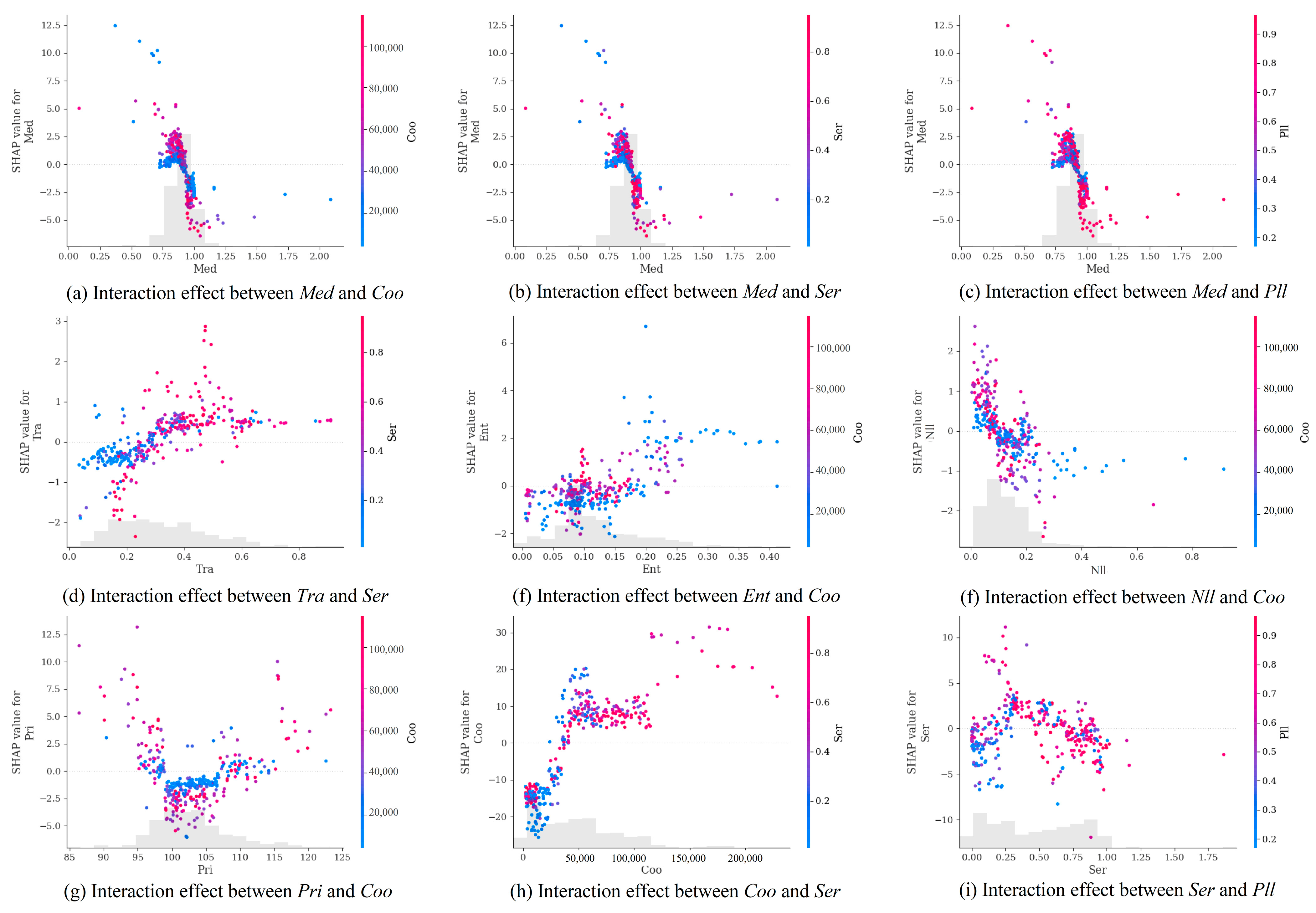
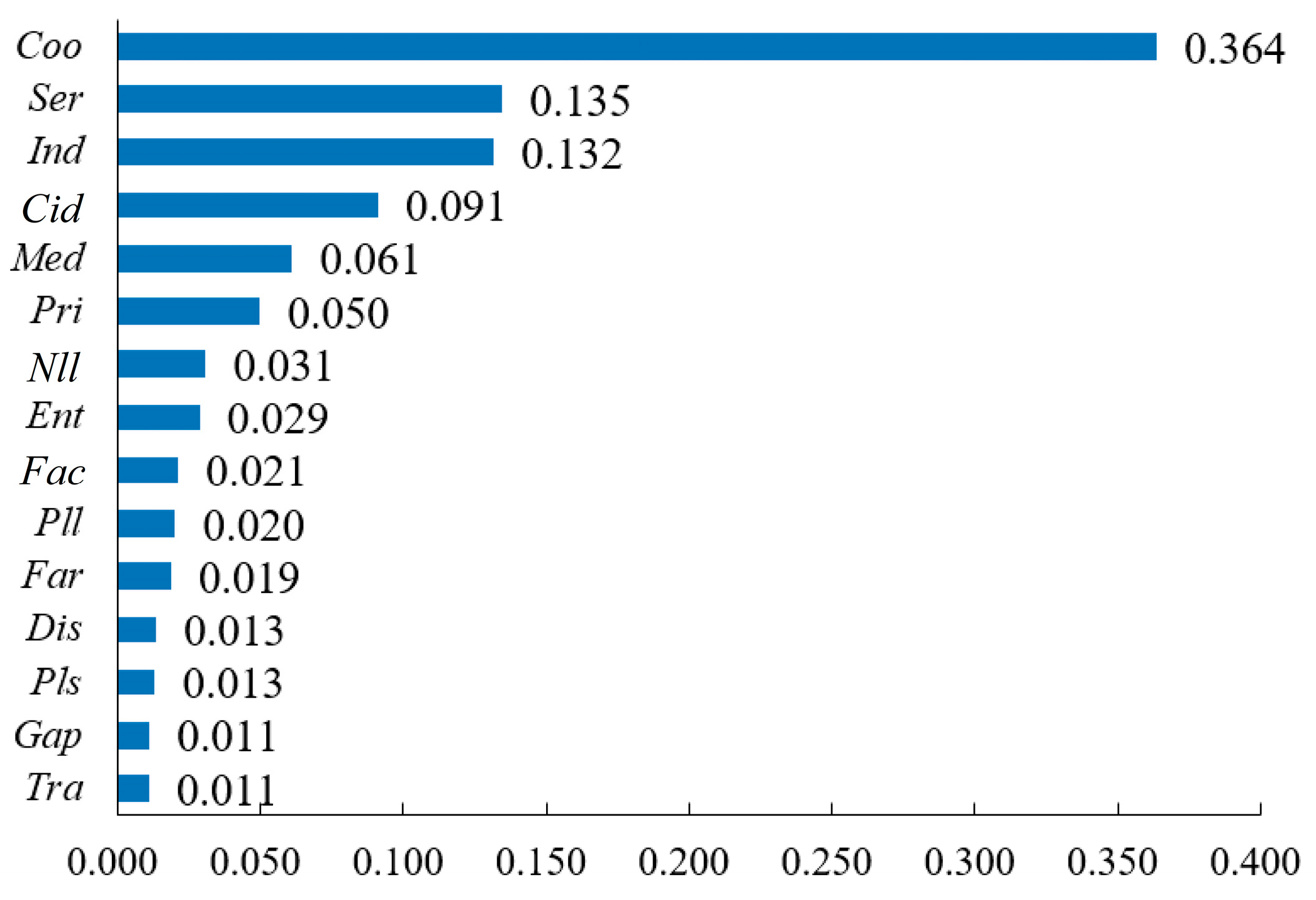
| Variables | Definition | Calculation Methods | Data Sources |
|---|---|---|---|
| GDP | Per capita GDP (CNY) | Total GDP/population | EPSDATA (https://www.epsnet.com.cn, accessed on 2 August 2024) |
| Urb | Urbanization level | Urban population/total population | |
| Gap | Urban–rural gap | Urban-to-rural disposable income ratio | |
| Ind | Share of primary industry | Primary sector value-added/GDP | |
| Fin | Financial support for agriculture | Agri-expenditure/fiscal expenditure | |
| Pri | Agricultural product price index | / | |
| Pop | Natural population growth rate (‰) | Net increase/population × 1000‰ | National Bureau of Statistics (https://www.stats.gov.cn, accessed on 2 August 2024) |
| Lab | Number of migrant labors (104 persons) | / | |
| Edu | Education level | Population with high school education or above/total population | |
| Coo | Number of specialized farmers’ cooperatives | / | China Rural Management Statistical Yearbook (2011–2018); China Rural Policy and Reform Statistical Yearbook (2019–2022) |
| Far | Number of family farms | / | |
| Ref | Completion rate of property rights reform | Villages completing reform/total villages | |
| Ser | Coverage of land transfer service centers | Number of land transfer centers/number of townships | |
| Arb | Number of arbitration committees | / | |
| Fac | Proportion of farmer in arbitration committee | Number of farmer representatives/committee members | |
| Med | Mediation rate of non-litigation disputes | Mediated disputes/total land disputes | |
| Cid | Proportion of collective income distributed to farmers | Income distributed to farmers/collective income | |
| Lp | Land price (Yuan/ha) | Total land transaction cost/land acquisition area | National Bureau of Statistics (https://www.stats.gov.cn, accessed on 2 August 2024) |
| Acl | Average cultivated land per household (ha) | Area of cultivated land/total households | China Rural Management Statistical Yearbook (2011–2018); China Rural Policy and Reform Statistical Yearbook (2019–2022) |
| Tra | Ratio of cultivated land transfer | Transferred area/area of cultivated land | |
| Pls | Proportion of land shareholding | Area for equity shares/transfer area | |
| Pla | Proportion of land assignment | Area for assignment/transfer area | |
| Pll | Proportion of land leasing | Area for lease/transfer area | |
| Pea | Proportion of land transferred to peasants | Transferred to peasants/transfer area | |
| Uni | Proportion of land transferred to unions | Transferred to farmer unions/transfer area | |
| Ent | Proportion of land transferred to enterprises | Transferred to enterprises/transfer area | |
| Nft | Proportion of non-food land transfer | Non-food transfer/transfer area | |
| Nll | Proportion of land leased to non-locals | Leased to non-locals/total leased area | |
| Com | land expropriation compensation (104 CNY) | Land compensation fees/area of expropriated land | |
| Reg | land registration and certification | Certificates issued/number of households | |
| Lcs | Percentage of land contract signing | Land contracts/number of households | |
| Tcs | Ratio of transfer contract signing | Transfer contracts/number of households who transferred their land | |
| Dis | Disaster-affected sown area (kha) | / | EPSDATA (https://www.epsnet.com.cn, accessed on 2 August 2024) |
| Variables | Definition | Min | Max | Med | Std | Sample |
|---|---|---|---|---|---|---|
| LDI | Land dispute intensity | 0.000 | 130.000 | 15.025 | 27.323 | 360 |
| Gap | Urban–rural gap | 1.830 | 3.930 | 2.450 | 0.403 | 360 |
| Ind | Share of primary industry | 0.002 | 0.251 | 0.092 | 0.052 | 360 |
| Pri | Agricultural product price index | 86.400 | 123.300 | 102.400 | 5.745 | 360 |
| Coo | Number of specialized farmers’ cooperatives | 2261.000 | 228,738.000 | 42,273.000 | 40,850.183 | 360 |
| Far | Number of family farms | 173.000 | 578,460.000 | 12,243.000 | 77,098.331 | 360 |
| Ser | Coverage of land transfer service centers | 0.000 | 1.867 | 0.471 | 0.331 | 360 |
| Fac | Proportion of farmers in arbitration committee | 0.064 | 0.855 | 0.195 | 0.101 | 360 |
| Med | Mediation rate of non-litigation disputes | 0.084 | 1.000 | 0.898 | 0.133 | 360 |
| Cid | Proportion of collective income distributed to farmers | 0.000 | 0.514 | 0.044 | 0.082 | 360 |
| Tra | Ratio of cultivated land transfer | 0.034 | 0.911 | 0.305 | 0.169 | 360 |
| Pls | Proportion of land shareholding | 0.000 | 0.400 | 0.031 | 0.065 | 360 |
| Pll | Proportion of land leasing | 0.046 | 1.000 | 0.616 | 0.269 | 360 |
| Ent | Proportion of land transferred to enterprises | 0.006 | 0.412 | 0.100 | 0.072 | 360 |
| Nll | Proportion of land leased to non-locals | 0.003 | 0.915 | 0.113 | 0.102 | 360 |
| Dis | Disaster-affected sown area (kha) | 0.000 | 4224.000 | 534.000 | 736.513 | 360 |
| Model | R2 | MAE | MSE | RMSE |
|---|---|---|---|---|
| linear regression | 0.424 | 20.108 | 428.697 | 20.705 |
| Decision tree | 0.446 | 13.664 | 428.543 | 20.701 |
| Random forest | 0.602 | 12.679 | 308.178 | 17.555 |
| XGBoost | 0.592 | 11.987 | 315.637 | 17.766 |
| GBDT | 0.615 | 12.134 | 297.798 | 17.257 |
Disclaimer/Publisher’s Note: The statements, opinions and data contained in all publications are solely those of the individual author(s) and contributor(s) and not of MDPI and/or the editor(s). MDPI and/or the editor(s) disclaim responsibility for any injury to people or property resulting from any ideas, methods, instructions or products referred to in the content. |
© 2025 by the authors. Licensee MDPI, Basel, Switzerland. This article is an open access article distributed under the terms and conditions of the Creative Commons Attribution (CC BY) license (https://creativecommons.org/licenses/by/4.0/).
Share and Cite
Li, J.; Tong, B.; Tan, S.; Zou, S.; Zhang, J. Revealing the Driving Factors of Land Disputes in China: New Insights from Machine Learning and Interpretable Methods. Land 2025, 14, 1757. https://doi.org/10.3390/land14091757
Li J, Tong B, Tan S, Zou S, Zhang J. Revealing the Driving Factors of Land Disputes in China: New Insights from Machine Learning and Interpretable Methods. Land. 2025; 14(9):1757. https://doi.org/10.3390/land14091757
Chicago/Turabian StyleLi, Jiayin, Bin Tong, Shukui Tan, Shangjun Zou, and Junwen Zhang. 2025. "Revealing the Driving Factors of Land Disputes in China: New Insights from Machine Learning and Interpretable Methods" Land 14, no. 9: 1757. https://doi.org/10.3390/land14091757
APA StyleLi, J., Tong, B., Tan, S., Zou, S., & Zhang, J. (2025). Revealing the Driving Factors of Land Disputes in China: New Insights from Machine Learning and Interpretable Methods. Land, 14(9), 1757. https://doi.org/10.3390/land14091757





